Entry Descent and Landing Details
Sequence of Events:
07/04/97 16:32:28 UTC: Cruise Stage Separation 8,500 km from the Surface of Mars
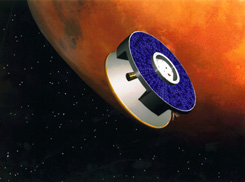 In this picture the royal blue surface is the solar panel that provides
Pathfinder with electricity while in route to Mars. Near the outer edge of
the solar panel is visible one of the hydrazine propellant attitude control
thrusters used to make corrections to Pathfinder's trajectory. These
systems together with a thermal control system form the major components of
the cruise stage. The silver surface beneith the solar cells is the top of
the cone shaped entry capsule, similar in design to the Apollo capsules
that safely brought men back from the Moon.
In this picture the royal blue surface is the solar panel that provides
Pathfinder with electricity while in route to Mars. Near the outer edge of
the solar panel is visible one of the hydrazine propellant attitude control
thrusters used to make corrections to Pathfinder's trajectory. These
systems together with a thermal control system form the major components of
the cruise stage. The silver surface beneith the solar cells is the top of
the cone shaped entry capsule, similar in design to the Apollo capsules
that safely brought men back from the Moon.
At "cruise stage separation", pyrotechnics are used to sever the lines and
fasteners that attached the cruise stage to the entry capsule.
Schematic of Cruise Stage and Entry Capsule:
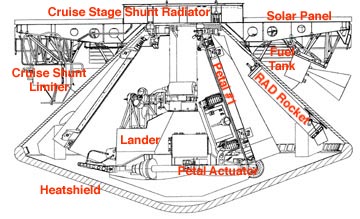
Back
Sequence of Events:
07/04/97 16:38:39 UTC: Earth Rise on Landing Site
07/04/97 17:02:28 UTC: Nominal Entry Point 130 km above Mars
07/04/97 17:03:39 UTC: Nominal Time of Peak Atmospheric Heating
07/04/97 17:03:49 UTC: Nominal Time of Peak Deceleration
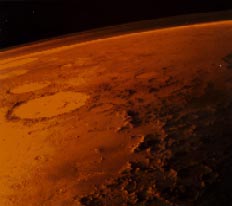 At approximately 16:38:39 UTC the Earth will become visible just over the
horizon at the location where Pathfinder will be landing. Approximately
four minutes later, the Pathfinder entry capsule will make contact with
the outer fringes of the Martian atmosphere at an altitude of 130
kilometers.
At approximately 16:38:39 UTC the Earth will become visible just over the
horizon at the location where Pathfinder will be landing. Approximately
four minutes later, the Pathfinder entry capsule will make contact with
the outer fringes of the Martian atmosphere at an altitude of 130
kilometers.
The Martian atmosphere is quite thin as compared to the Earth's atmosphere.
At an altitude of 130 km it's pressure is approximately 1/25 that of the
Earth's atmosphere. At ground level the Martian atmosphere has a pressure
of 6.518 millibars or 0.095 psi as compared to the Earth's sea level
atmospheric pressure of 14.7 psi. Peak atmospheric heating occurs at
approximately 17:03:39 UTC Earth receive time. At this point the heat
shield is preventing the entry capsule from burning up in the atmosphere
of Mars. The heat shield is composed of a cork wood, silicate, and epoxy
composite that liberates gases upon heating. These gases react with the
atmosphere in a catalytic chemical reaction which forms a boundary layer
during the ablation of the heat shield.
Approximately one minute later, the entry capsule enters a period of peak
deceleration. The maximum deceleration rate is 18.6 Gs or 182.5 meters per
second squared, or 598.9 feet per second squared. If a person who weighed
150 pounds on Earth were seated in the capsule at this point in the entry
phase, that person would weigh 2,790 pounds. Our electronics can easily
handle this stress, but a person would have difficulty.
Back
Sequence of Events:
07/04/97 17:05:09 UTC: Nominal Time of Parachute Deployment
07/04/97 17:05:29 UTC: Nominal Time of Heat Shield Separation
07/04/97 17:05:59 UTC: Nominal Time of Lander Separation
07/04/97 17:06:56 UTC: Approximate Time-Radar Altimeter Ground Acquisition - 1
mile above the ground
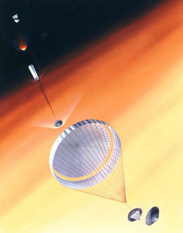 At approximately 17:05:09 UTC the parachute will deploy at an altitude of 8.6
kilometers or 5.3 miles.
At approximately 17:05:09 UTC the parachute will deploy at an altitude of 8.6
kilometers or 5.3 miles.
When a parachute is deployed in the earth's thick atmosphere there is a
short period of rapid deceleration. However, because the Martian atmosphere
is so thin, the rate of deceleration is gradual.
When the chute deploys, Pathfinder is traveling at a speed of 900 miles per
hour, or 392 meters per second. Approximately 83 seconds later, Pathfinder
has reached a terminal, or steady state, velocity of 134 miles per hour, or
64 meters per second. At this point more pyrotechnics fire to release the
heat shield from the back shell which forms the upper cone shaped surface
of the entry vehicle.
At approximately 17:05:59 UTC the lander separates away from the back shell
and descends on a tether. Approximately one minute later, the radar
altimeter in the lander will determine the height of Pathfinder above the
surface of Mars. As Pathfinder descends through the atmosphere, the radar
altimeter updates the flight computer to establish the exact times of the
remaining sequences.
Back
Sequence of Events:
07/04/97 17:07:08 UTC: Approximate Time of Air Bags Inflation
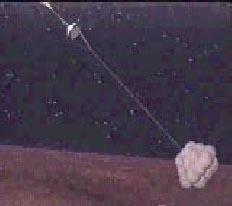 At approximately 17:07:08 UTC at an altitude of 200 meters, gas generators
fire to rapidly inflate panels composed of 6 air bags on each of the 4 sides
of the lander.
At approximately 17:07:08 UTC at an altitude of 200 meters, gas generators
fire to rapidly inflate panels composed of 6 air bags on each of the 4 sides
of the lander.
The air bags are made of Vectran and have a weight of 5.8 ounces per square
yard.
The air bags will inflate in 0.5 seconds at a pressure of 1.0 psi. These
bags will cushion Pathfinder during the final stage of the landing sequence.
Back
Sequence of Events:
07/04/97 17:07:12 UTC: Approximate Time of Solid Rocket Ignition
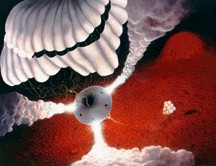 At approximately 17:07:12 UTC three solid propellant rockets on the inner
surface of the back shell fire to further slow down the decent rate of
the lander.
At approximately 17:07:12 UTC three solid propellant rockets on the inner
surface of the back shell fire to further slow down the decent rate of
the lander.
Each solid rocket motor consumes 30.7 kg of propellant over a period of 2.2
seconds, generating a thrust of 7,938 newtons. The decent is slowed down
from a rate of 58 meters per seconds, or 130 miles per hour, to a rate of
less than 20 meters per second, or 45 miles per hour.
This picture is an artist's rendition from a vantage point above Pathfinder,
looking down on the landing site.
Test of RAD Rockets
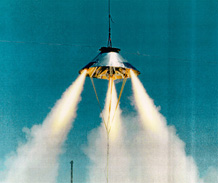
Back
Sequence of Events:
07/04/97 17:07:14 UTC: Approximate Time of Bridle Cut
07/04/97 17:07:16 UTC: Approximate Time of First Impact
07/04/97 17:08:14 UTC: Approximate Time of Roll Stop
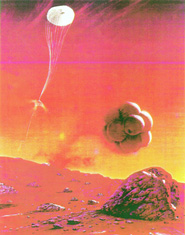 At approximately 17:07:14 UTC at a height of 10 meters or 32 feet, the bridle
is cut and the Pathfinder probe falls the remaining distance to the surface
of Mars.
At approximately 17:07:14 UTC at a height of 10 meters or 32 feet, the bridle
is cut and the Pathfinder probe falls the remaining distance to the surface
of Mars.
Gravity on Mars is about one third that of Earth, so the impact velocity
will be less than if the lander was dropped from the same height on Earth.
The velocity at impact will be around 45 mph, or 72 Kph, and the
deceleration on the first bounce will be less than 40 Gs.
Back
Sequence of Events:
07/04/97 17:09 UTC: Approximate Time Air Bag Retraction Begins
07/04/97 18:00 UTC: Approximate Time Air Bag Retraction Complete
07/04/97 18:21 - 19:22 UTC: Approximate Time Petal Opening Complete
07/04/97 20:50 UTC: Sunrise at Landing Site
07/04/97 21:09 UTC: First Information Received at Earth
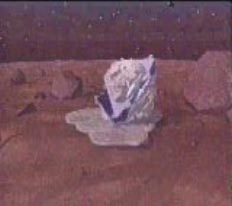 At this point in the landing sequence the slow process of air bag retraction
begins.
At this point in the landing sequence the slow process of air bag retraction
begins.
Within each air bag panel are cords which attach to the far inner surface of
the air bags. These cords are used to draw the air bags back to the surface
of each of the four sides of the lander. This must be done to ensure that
the petals of the lander do not become entangled with the air bags as the
lander unfolds.
Back
Sequence of Events:
07/05/97 01:00 UTC: Rover Ramp Deployment
07/05/97 03:58 UTC: Rover Deployment
07/05/97 04:24 - 05:26 UTC: Rover on Mars Image, B&W 360 Pan
07/05/97 05:30 UTC: Sunset at Landing Site
07/05/97 07:00 - 08:00 UTC: Rover on Mars, B&W 360 Pan Images Available?
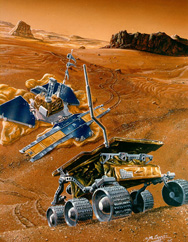 This artist's rendition shows the Pathfinder lander in its final
configuration on the surface of Mars.
This artist's rendition shows the Pathfinder lander in its final
configuration on the surface of Mars.
The rover "Sojourner" in the foreground is deployed off one of the petals.
The upper surface of each petal is a solar panel which provides the
Pathfinder probe with its power.
The rover is powered by a solar array on its top surface.
Back
This sequence was made possible by:
Kirk Goodall, Mars Pathfinder Web Engineer
Gordon Wood, Mars Pathfinder Flight Engineer
Updated: July 3 '97
Best seen with MS Internet Explorer.
Back to the Mars Pathfinder EDL Sequence Page
Messages:
Communications
 In this picture the royal blue surface is the solar panel that provides
Pathfinder with electricity while in route to Mars. Near the outer edge of
the solar panel is visible one of the hydrazine propellant attitude control
thrusters used to make corrections to Pathfinder's trajectory. These
systems together with a thermal control system form the major components of
the cruise stage. The silver surface beneith the solar cells is the top of
the cone shaped entry capsule, similar in design to the Apollo capsules
that safely brought men back from the Moon.
In this picture the royal blue surface is the solar panel that provides
Pathfinder with electricity while in route to Mars. Near the outer edge of
the solar panel is visible one of the hydrazine propellant attitude control
thrusters used to make corrections to Pathfinder's trajectory. These
systems together with a thermal control system form the major components of
the cruise stage. The silver surface beneith the solar cells is the top of
the cone shaped entry capsule, similar in design to the Apollo capsules
that safely brought men back from the Moon.
 At approximately 16:38:39 UTC the Earth will become visible just over the
horizon at the location where Pathfinder will be landing. Approximately
four minutes later, the Pathfinder entry capsule will make contact with
the outer fringes of the Martian atmosphere at an altitude of 130
kilometers.
At approximately 16:38:39 UTC the Earth will become visible just over the
horizon at the location where Pathfinder will be landing. Approximately
four minutes later, the Pathfinder entry capsule will make contact with
the outer fringes of the Martian atmosphere at an altitude of 130
kilometers. At approximately 17:05:09 UTC the parachute will deploy at an altitude of 8.6
kilometers or 5.3 miles.
At approximately 17:05:09 UTC the parachute will deploy at an altitude of 8.6
kilometers or 5.3 miles. At approximately 17:07:08 UTC at an altitude of 200 meters, gas generators
fire to rapidly inflate panels composed of 6 air bags on each of the 4 sides
of the lander.
At approximately 17:07:08 UTC at an altitude of 200 meters, gas generators
fire to rapidly inflate panels composed of 6 air bags on each of the 4 sides
of the lander. At approximately 17:07:12 UTC three solid propellant rockets on the inner
surface of the back shell fire to further slow down the decent rate of
the lander.
At approximately 17:07:12 UTC three solid propellant rockets on the inner
surface of the back shell fire to further slow down the decent rate of
the lander.
 At approximately 17:07:14 UTC at a height of 10 meters or 32 feet, the bridle
is cut and the Pathfinder probe falls the remaining distance to the surface
of Mars.
At approximately 17:07:14 UTC at a height of 10 meters or 32 feet, the bridle
is cut and the Pathfinder probe falls the remaining distance to the surface
of Mars. At this point in the landing sequence the slow process of air bag retraction
begins.
At this point in the landing sequence the slow process of air bag retraction
begins. This artist's rendition shows the Pathfinder lander in its final
configuration on the surface of Mars.
This artist's rendition shows the Pathfinder lander in its final
configuration on the surface of Mars.